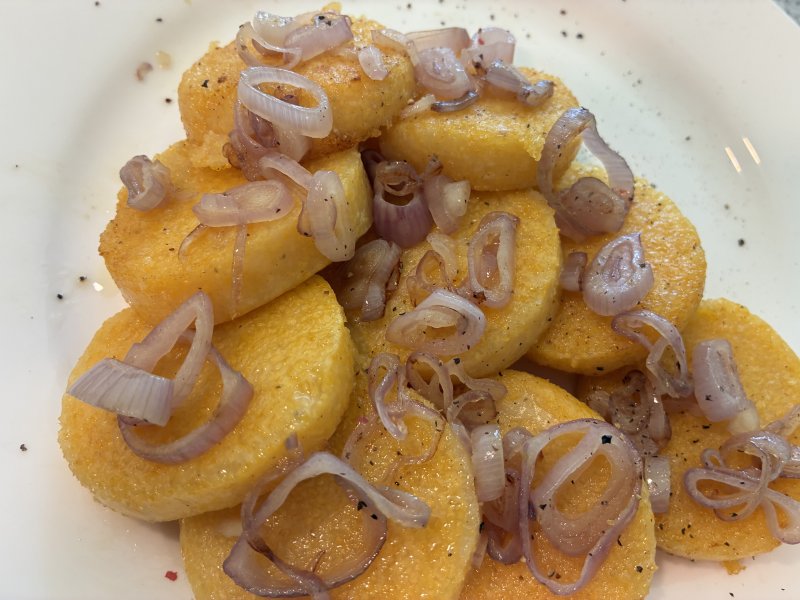Rediscover comfort, versatility of polenta
On a recent shopping trip, I noticed a plastic-wrapped roll of polenta chilling in the produce aisle. This reminded me how much I enjoyed this corn-centric staple as a tasty side dish and also how little I enjoyed the time-consuming process to prepare it. The ready-to-go alternative would give me an easy way to serve polenta, without spending time stirring a spitting pot of cornmeal.
By way of explanation, polenta is coarse-ground cornmeal cooked into a porridge or mush. It can be served soft and creamy (like mashed potatoes) or cooled until firm, then sliced and sautéed. That roll of polenta at the grocery store had already been cooked and cooled, ready to slice and heat in a buttered skillet.
There is sometimes confusion between polenta and cornmeal. While both are made from ground corn, polenta is both the name of a dish and a specific type of cornmeal, and cornmeal is an ingredient made by grinding dried corn kernels – yellow, white or blue – into fine, medium and coarse textures. Polenta is made from a specific variety of corn called flint corn and typically stone-ground to a rather coarse texture.
Traditionally, polenta is slow-cooked in water until the grains swell and starches are released. Towards the end of the preparation, it’s combined with other ingredients, from butter and cheese to sauces and gravies. At this point, the dish has a thick, smooth consistency and is ready to serve, topped with any number of ingredients. Once cooled, the polenta hardens and can be cut into pieces and crisped.
Although corn wasn’t known in Europe until explorers returned from the Americas, corn quickly became a popular food in Italy during the seventeenth century. The inexpensive ingredient was the basis for filling, warm porridges. Unfortunately, the Italian farmers who ate polenta didn't realize it was missing a key vitamin, B3, and many developed the disease known as Pellagra.
Indigenous peoples of the Americas had learned how to avoid this condition by boiling corn with lime or wood to release niacin into the mush, a process called nixtamalization. They also ate a varied diet, consuming a range of essential vitamins and minerals. The Italians who ate a steady diet of little else but polenta were plagued with widespread disease in the areas where polenta was most common.
For older generations, polenta might be associated with poverty, but in modern cuisine, we have seen polenta become a popular palate for creative chefs. The key to enlivening the potentially bland flavor is to add cheese and herbs during the final moments of the boiling and stirring steps, much like you would for risotto. Toppings such as pesto or spicy tomato relish can add a new dimension to a dish of polenta.
Polenta can become a flavorful bed on which to plate lamb shanks or veal ragu. Crunchy-crusted polenta cakes pair nicely with simmered chicken in gravy. For the polenta cakes in the photo, sliced shallots were sautéed and scattered over the tops. Alternatively, you can find polenta (coarse-ground cornmeal) in sweet dishes, such as this recipe for a lemon polenta cake.
When making creamy polenta, be patient and diligent, as the process can take close to an hour. You can serve it just as it is when finished, as a delicious side dish or companion to grilled meat. Alternatively, place it in a loaf pan to set, then slice and sauté.
Creamy Polenta
4 C water or stock
1 C polenta*
1 t salt
2 T butter
1/2 C grated Parmesan cheese
In a large saucepan, whisk together liquid, polenta, and salt. Bring to a simmer over medium high heat, whisking constantly. Reduce heat to low and cook until thickened and tender, stirring regularly, about 45 minutes. Once cooked, stir in butter and cheese. Yield: 4 to 6 servings.
*Note: Bob’s Red Mill polenta coarse ground cornmeal is a good choice.
Polenta Cake
1 C polenta*
3/4 C flour
1 1/2 t baking powder
1/2 t salt
2 eggs
2 egg whites
1 C sugar
1/4 C olive oil
2 T softened butter
1/2 C sour cream
2 T lemon zest
2 T lemon juice
powdered sugar
Preheat oven to 350F. Line an 8-inch cake pan with parchment and coat with nonstick cooking spray; set aside. In a small bowl, whisk together polenta, flour, baking powder, and salt; set aside. In the bowl of a stand mixer, beat eggs, egg whites, and sugar on medium-high until pale and creamy, about 5 minutes. Reduce speed to low and mix in oil, butter, sour cream, lemon zest and juice. Add dry ingredients and stir just until combined. Pour batter into prepared pan. Bake until top is firm and a tester comes out clean, about 35 to 40 minutes. Allow to cool and sift powdered sugar over top to serve.
*Note: Bob’s Red Mill polenta coarse ground cornmeal is a good choice.























































